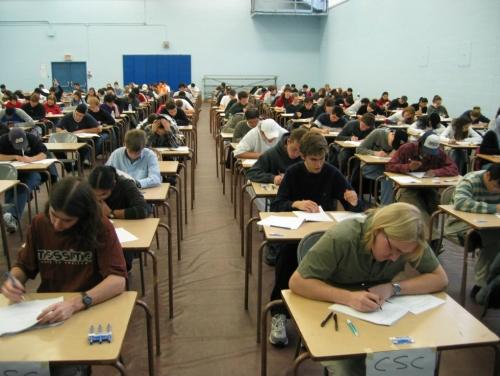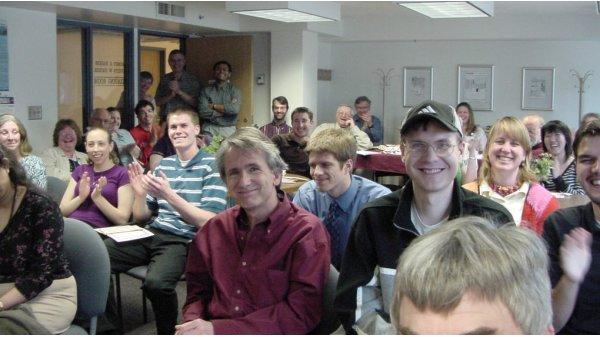No tests, quizzes, exams and no homework
Posted by: Gary Ernest Davis on: January 25, 2010
Yes, that’s right: this semester all 3 mathematics courses I am teaching are devoid of tests, quizzes, examinations and homework.  The courses are:
The courses are:
- Ordinary differential equations (37 students)
- Mathematical statistics (12 students)
- Mathematical modeling of cellular networks (22 students)
The differential equations class consists entirely of undergraduate engineering students. Â This class is structured into two quarters, each of 7 weeks. In each quarter students will work in groups on two substantial projects in differential equations.
The topic for the first project for the first quarter is Newton’s law of cooling and its (mis)application to estimating time of death. Apart from the law of cooling with constant ambient temperature, students will investigate what happens if the ambient temperature varies linearly – say over early morning to early afternoon – and cyclically, as it might over several days.
The second project for the first quarter is numerical approximation of solutions of non-linear systems of differential equations, using increasingly sophisticated numerical schemes – Euler’s method, modified Euler, order Runge-Kutta, and use of MATLAB ODE solvers.
Students will work in groups of 4 to prepare two poster presentations for the break in week eight. Each student will keep a WordPress blog where they will write up individual accounts of their project work. WordPress is useful for this purpose because it has a full implementation of AMS LaTeX.
The mathematical statistics class is a mix of mathematics majors, computer science students and engineering majors. In this class students work on core applied projects from the outstanding book StatLabs by Deborah Nolan and Terry Speed. This is a book designed to teach mathematics majors how to apply mathematical statistics and learn to become mathematical scientists.
The  mathematical modeling of cellular networks course has an eclectic mix of students ranging from a Ph.D. student in electrical engineering to a high school senior enrolled as a non-degree undergraduate.
The book is a research-based text, written for graduate students, on recent advances in modeling protein-protein interactions in cellular networks.
Students in this course will learn to think like scientists – to have ideas, to test them, to be honest in reporting, and to have respect for other’s opinions and ideas. They will also learn that learning outside of the usual protected, managed classroom environment is generally messy, with many false starts.
Testing is crap, so far as I am concerned. I can devise a test so that all students pass well, all students fail miserably, and all shades in between, so that only a very careful expert could tell how I manipulated the outcome. Simply changing the order of questions can dramatically affect student test scores.
I am no longer interested in the  post WWII obsession with testing and checking, as if students were being assigned to an army corps.
I am vitally interested in students who, at the prime of their intellectual lives, are deeply interested in science and mathematics, and who want to make a difference, in the world.
I am interested in the students who are scarred by colleagues who set absurd and arcane tests – students who are wounded and deserve a chance to show how they can shine.
I don’t want my students sweating over grubby tests.
I want them to shine, to catch fire, to become impassioned and to want to make their mark on the world – to make a difference.
The most basic mathematical idea ?
Posted by: Gary Ernest Davis on: January 24, 2010
My ex-wife used to wonder what was the difficulty in forming, or talking about, the set of all natural numbers. This was not a reason for our eventual separation.  It did, however, cause her some angst in wondering why we can’t just imagine all the counting numbers bundled together in a set:
$latex \{1, 2, 3, 4, 5 ,\ldots \}$
My explanation to her involved three things:
1. Bertrand Russell’s apparent paradox of the set S of all sets that do  not belong to themselves (does S belong to itself or not?). This is a so-called paradox of naive set theory in which there are few restrictions on the formation of sets.
2. A consequent need to formalize the process of set formation, for example, as in the axioms specified in Zermelo-Fraenkel set theory.
3. The perhaps surprising fact that Zermelo-Fraenkel set theory without the axiom of infinity has models with only finite sets. So to even assert that there is a formally constructed set of natural numbers we need to assert, as an axiom, that there is an infinite set.
This formal axiom is based on our informal, or naive, experience that for any number to which we have counted we can, at least in imagination, count one more.
There is no doubt that we count and that, unless we are too tired, can always count one more. But this experiential fact does not, in itself, justify our assertion that there exists a set of all natural numbers.
What we are doing in asserting the existence of the set of natural numbers is making real something that is an idea. This process is usually called reification, in which an abstraction is treated as if it were a concrete, real physical entity.
So at the heart of mathematics lies an act of reification, a taking as real some thing – the set of natural numbers – that is an abstraction from our human activity of counting.
The process of reification is explicitly addressed in Buddhist thought, where it is generally thought to be not a good thing because it leads to the delusion of permanence for mental constructions that are bound to decay:
“All things and events, whether ‘material’, mental or even abstract concepts like time, are devoid of objective, independent existence. … things and events are ’empty’ in that they can never possess any immutable essence, intrinsic reality or absolute ‘being’ that affords independence.”  Dalai Lama (2005). The Universe in a Single Atom: The Convergence of Science and Spirituality. Broadway. ISBN 076792066X & ISBN 978-0767920667
Yet, to a mathematician, at least all those I have met or read, the natural numbers do indeed have an immutable essence. The set of natural numbers is as real and permanent to most mathematicians as any physical reality.
Once mathematicians have accepted the reality of the set of natural numbers they can begin to ask questions. A very early observation about the set of natural numbers is that every natural number  has a decomposition, in an essentially unique way (apart from rearrangement), as a product of natural numbers that themselves are ‘prime’ – that is,  can only can only be expressed as a product of the number 1 and themselves. Examples of prime numbers are 2, 3, 5, 7, 11, and 13.
It is a fact about natural numbers  that 53 is prime number.
It is a deeper fact that there are infinitely many prime numbers.
It is an even deeper fact that the the prime number is approximately equal to
, with the relative error of this approximation approaching 0 as
 increases without bound.  Here
is the natural logarithm of
: Â the area under the curve
from
.
Many mathematicians believe, but no-one has yet proven, that an even deeper fact is true about natural numbers (Riemann’s zeta hypothesis).
To me this is a very odd and puzzling issue. I have considerable respect for the Buddhist point of view on impermanence. Heraclitus’ statement about not being able to step into the same river twice also relates to the impermanence of a supposed object which we have reified through the word “river”.
We might, daily, look up the likely low temperature estimate, yet there is no real thing called “temperature’ – just readings, for example, of the height of a mercury column. The “temperature” is a mental construct to be found nowhere in the physical world.
Yet physics, and science in general, thrive on constructs such as “temperature”, “pressure”, speed”, and “force” , which can be defined operationally, but are taken by most scientists to refer to an objective reality.
So in mathematics we treat the abstract construct of the set of natural numbers as a real object and then discover deep properties of this abstracted set.
On such myths mathematics and science thrive!


